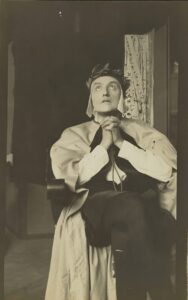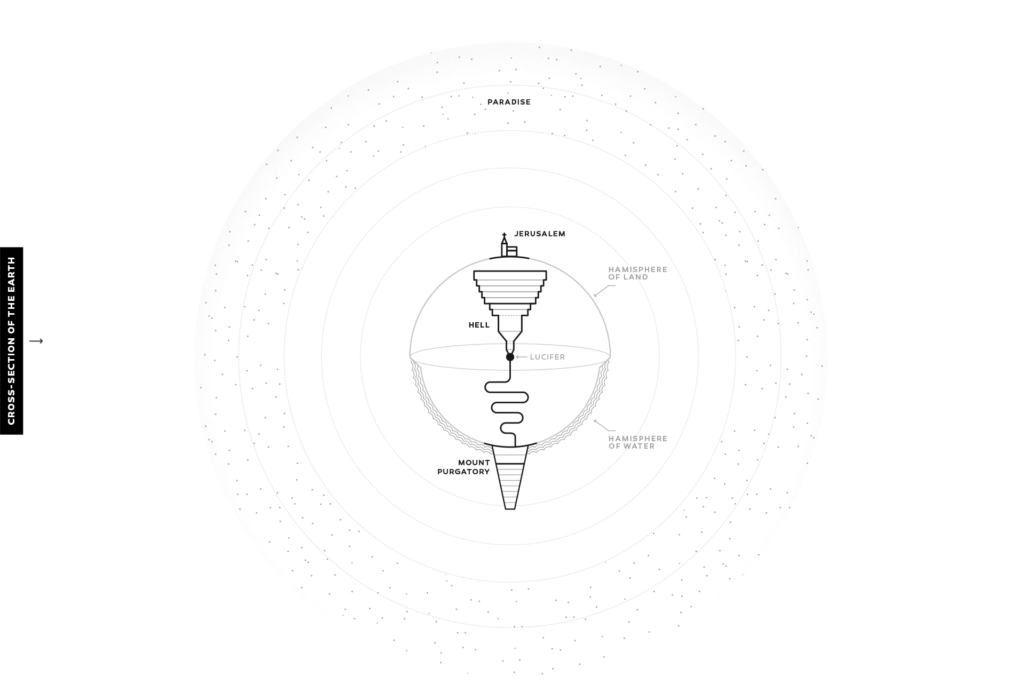Tumblr post by user Florence Leyret Photography captioned a post with the last line of Paradiso —Florence Leyret, “The love that moves the sun and the other stars…,” Tumblr, February 4, 2017 (retrieved February 29, 2024)
“Models and the Making of Violet Oakley’s Dante Window”
“The papers of Violet Oakley contain primary sources that reveal some of what she required of her models. She called on her friend, the illustrator Mills Thompson, as she prepared the stained glass Dante Window. (The Smithsonian American Art Museum owns a scale model; the work is in the Apostolic Nunciature of the Holy See to the United States.) Draped in cloth resembling Renaissance garb, donning a laurel wreath, and wearing a prosthetic nose, Thompson posed for a series of reference photographs that Oakley used in creating the window which was based on the Dante Alighieri’s fourteenth-century poem The Divine Comedy.
[. . .]
“Like the epic poem, the window is divided into three parts with four medallions each: the left panel represents the Inferno, (meant to be read from top to bottom), the right panel, Purgatorio, (read from the bottom), and the center section, Paradiso (also read from the bottom). In this group of twenty photographs, an animated Thompson personifies the character of Dante as he ponders, prays, attempts to ward off beasts, travels through Hell and Purgatory with Virgil, and ascends to Heaven with Beatrice. (Henrietta Cozens, who likely posed as Virgil for the image in medallion two of the Purgatorio panel, is not quite as vigorous in her expression.)” —Elizabeth Botten, “Models and the Making of Violet Oakley’s Dante Window”, Smithsonian Blog, June 17, 2014 (retrieved February 29, 2024)
“And the Love That Moves the Sun and Other Stars…,” Michelle Marie
Graphic artist and owner of the blog Tell Me About It draws inspiration from the famous last line of Paradiso, and therefore The Divine Comedy—Michelle Marie (username MICHELLEMARIE), “And the Love That Moves the Sun and Other Stars…,” Tell Me About It, January 17, 2015 (Retrieved February 29, 2024)
Infographic Illustration of The Divine Comedy
“Dante’s Divine Comedy’s fourth full translation to Hungarian was created by Adam Nadasdy, as a result of eight years of research a modern and clear translation was created just as Dante’s original work in his own time. I was asked to create infographics to the book. My goal was to create clean, minimalistic and accurate illustrations so that the readers will be able to understand the different locations and Dante’s path – Hell, Purgatory and Paradise.” —Janos Baksa, Adobe Behance, June 2, 2016 (retrieved on February 29, 2024)
Further illustrations of each circle, terrace, and heaven can be found here
Franz von Stuck, Inferno

“This painting’s title refers to Dante Alighieri’s medieval epic of a journey through hell. Although Stuck employed traditional symbols of the underworld—a snake, a demon, and a flaming pit—the dissonant colors and stylized, exaggerated poses are strikingly modern. He designed the complementary frame. Stuck’s imagery was likely inspired by Auguste Rodin’s The Gates of Hell, particularly the figure of The Thinker (see related works nearby). When Inferno debuted in an exhibition of contemporary German art at The Met in 1909, critics praised its ‘sovereign brutality.’ The picture bolstered Stuck’s reputation as a visionary artist unafraid to explore the dark side of the psyche.” —Franz von Stuck, Inferno, The Metropolitan Museum of Art, 1908 (retrieved February 28, 2024)
- « Previous Page
- 1
- …
- 6
- 7
- 8
- 9
- 10
- …
- 13
- Next Page »




